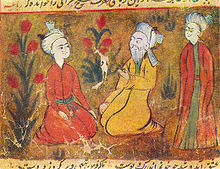
Back Urdua poezio Esperanto شعر اردو Persian שירה באורדו HE उर्दू शायरी Hindi ਉਰਦੂ ਸ਼ਾਇਰੀ Punjabi Poezja urdu Polish اردو شاعری PNB اردو شاعری Urdu
This article should specify the language of its non-English content, using {{lang}}, {{transliteration}} for transliterated languages, and {{IPA}} for phonetic transcriptions, with an appropriate ISO 639 code. Wikipedia's multilingual support templates may also be used. (May 2024) |

Urdu poetry (Urdu: اُردُو شاعرى Urdū šāʿirī) is a tradition of poetry and has many different forms. Today, it is an important part of the culture of India and Pakistan. According to Naseer Turabi, there are five major poets of Urdu: Mir Taqi Mir (d. 1810), Mirza Ghalib (d. 1869), Mir Anees (d. 1874), Muhammad Iqbal (d. 1938) and Josh Malihabadi (d. 1982). The language of Urdu reached its pinnacle under the British Raj, and it received official status. All famous writers of Urdu language including Ghalib and Iqbal were given British scholarships.[1] Following the Partition of India in 1947, it found major poets and scholars were divided along the nationalistic lines. However, Urdu poetry is cherished in both the nations. Both the Muslims and Hindus from across the border continue the tradition.
It is fundamentally performative poetry and its recital, sometimes impromptu, is held in Mushairas (poetic expositions). Although its tarannum saaz (singing aspect) has undergone major changes in recent decades, its popularity among the masses remains unaltered. Mushairas are today held in metropolitan areas worldwide because of the cultural influence of the South Asian diaspora. Ghazal singing and Qawwali are also important expository forms of Urdu poetry.
- ^ Paul R. Brass (2005). Language, religion, and politics in North India. Lincoln, Neb.: IUniverse. ISBN 978-0-595-34394-2.